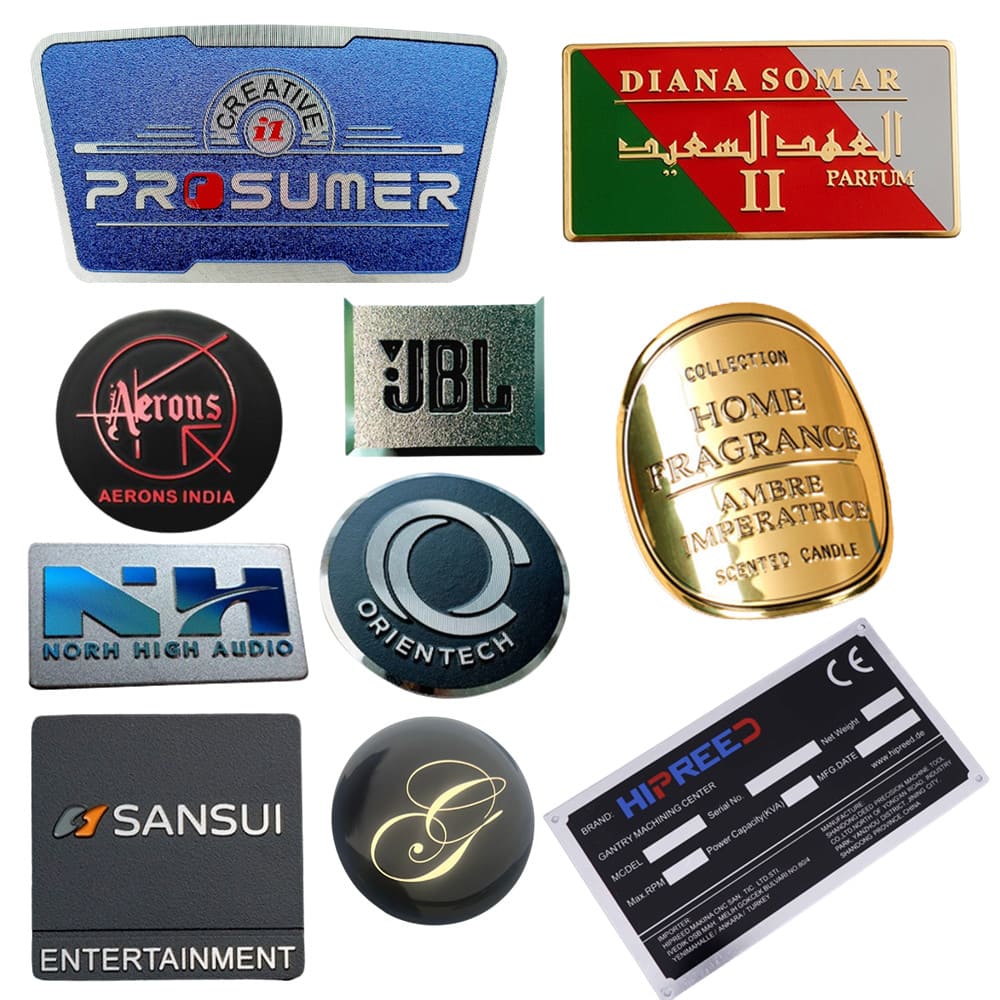Metal labels are among the most durable labeling solutions due to their robust construction and resistance to various environmental factors. Typically made from materials such as aluminum, stainless steel, or brass, these labels offer exceptional durability and longevity, making them suitable for a wide range of applications.
What are the metal labels’ benefits?
- Durability: Metal labels are highly resistant to corrosion, abrasion, and fading, ensuring they remain readable and intact even in harsh environments.
- Temperature resistance: Metal labels can withstand extreme temperatures, making them suitable for both indoor and outdoor use, as well as in applications where temperature fluctuations are common.
- Chemical resistance: Many metals used for labels are resistant to chemicals, oils, solvents, and other harsh substances, ensuring the label remains legible and functional in challenging conditions.
- Customization: Metal labels can be customized with various printing methods, including laser engraving, embossing, etching, or digital printing, allowing for precise and detailed designs to meet specific branding or identification needs.
- Versatility: Metal labels are versatile and can be used in a wide range of industries and applications, including industrial equipment labeling, asset tracking, machinery identification, signage, nameplates, and more.
- Professional appearance: Metal labels offer a high-quality, professional appearance, making them ideal for applications where aesthetics and durability are essential.
- Longevity: With proper care and maintenance, metal labels can last for many years without needing replacement, providing a long-term labeling solution that reduces the need for frequent re-labeling or maintenance.
How long metal label can last?
The lifespan of a metal label can vary depending on several factors, including the material used, environmental conditions, surface protection, and installation method.
- Material: The type of metal used for the label can significantly impact its lifespan. Stainless steel and aluminum are commonly used for metal labels due to their corrosion resistance and durability. These metals can last for decades, even in harsh environments.
- Environmental Conditions: The environment in which the metal label is installed plays a significant role in its lifespan. Exposure to extreme temperatures, moisture, UV radiation, chemicals, and pollution can affect the durability of the label. Metal labels installed indoors or in controlled environments may last longer than those exposed to harsh outdoor conditions.
- Surface Protection: Metal labels can be coated or treated to enhance their resistance to corrosion, abrasion, and fading. Protective coatings such as anodizing, powder coating, or clear coating can extend the lifespan of the label by providing an additional layer of protection against environmental elements.
- Installation Method: Proper installation is crucial for ensuring the longevity of a metal label. Secure mounting methods, such as welding, adhesive bonding, or mechanical fastening, can help prevent the label from becoming loose or damaged over time.
In general, well-maintained metal labels made from durable materials like stainless steel or aluminum can last for many years, often decades, even in demanding environments.
How to make a metal label?
- Design: Start by designing your metal label using graphic design software like Adobe Illustrator or CorelDRAW. Determine the size, shape, text, and any graphics or logos you want to include. Ensure that your design is suitable for the manufacturing process you’ll be using.
- Find a reliable manufacturer. A reliable manufacturer not only saves you time and money but also enhances the level of your brand. Our company in the metal label industry for 20 years and served over 10000+ brands. No matter what kind of effect you want, we can give solutions and prices in a short time.
- Material selection. Choose the type of metal you want to use for your labels. Common choices include stainless steel, aluminum, brass, and zinc alloy. Consider factors such as durability, appearance, and cost when selecting the material.
- Production crafts selection. Creating metal label products involves various crafts and techniques. Here’s an overview of some common methods used in metal label production: Metal Etching, Embossing and Debossing, Stamping and Die-Cutting, Engraving, Anodizing and Plating, Painting and Coloring, etc. By combining these crafts and techniques, manufacturers can create a wide variety of metal label products with different designs, finishes, and functionalities to suit various applications and industries. If cooperate with us, we will give options and prices according to your design and application.
- Sample check. Before mass production, you can ask for a sample to check quality.
- Mass production and shipping. We can ship metal labels to the whole world.
What’s the metal label application?
Metal labels find application in various industries and settings where durability, permanence, and a professional appearance are desired. Some common applications of metal labels include:
- Product Identification: Metal labels are often used for product branding, model numbers, serial numbers, and other identification purposes. They provide a durable and visually appealing way to mark products, equipment, and machinery.
- Asset Tags and Labels: Metal labels are commonly used as asset tags for inventory management, asset tracking, and equipment identification in industries such as manufacturing, logistics, healthcare, and utilities.
- Nameplates and Name Tags: Metal labels are used for nameplates, name tags, and signage in commercial, industrial, and institutional settings. They provide a professional appearance and withstand long-term use and handling.
- Control Panels and Instrumentation: Metal labels are used for labeling control panels, instrumentation, switches, and gauges in various industries, including aerospace, automotive, electronics, and manufacturing.
- Safety and Warning Labels: Metal labels are used for safety signs, warning labels, and hazard communication in workplaces, construction sites, industrial facilities, and public spaces. They provide durable and highly visible signage for safety purposes.
- Decorative and Architectural Signage: Metal labels are used for decorative and architectural signage in commercial buildings, public spaces, and outdoor environments. They offer a sophisticated and long-lasting solution for branding, wayfinding, and information display.
- Identification Plates and Tags: Metal labels are used for identification plates, tags, and markers in applications such as machinery, equipment, vehicles, and infrastructure. They provide permanent marking for tracking and traceability purposes.
- Promotional and Branding Materials: Metal labels are used for promotional items, merchandise, gifts, and branding materials. They offer a premium look and feel that enhances the perceived value of the product or brand.
- Industrial and Manufacturing Labels: Metal labels are used in industrial and manufacturing environments for process labeling, equipment labeling, and facility signage. They withstand harsh conditions such as high temperatures, chemicals, and abrasion.
- Outdoor and Harsh Environment Labels: Metal labels are suitable for outdoor and harsh environment applications where durability and weather resistance are essential. They withstand exposure to UV radiation, moisture, temperature fluctuations, and harsh chemicals.
If you want to know what a metal label looks like, please reference our metal label website. https://custometalcrafts.com/custom-metal-labels/
Sending your requirements to us, we will give solutions and prices within 12 hours.


